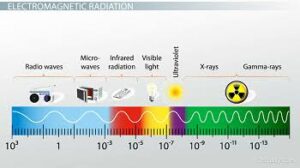Back to: Organic Chemistry 300 Level
Welcome to class!
Hello, superstar learner! Today, we begin our journey into one of the most powerful tools in modern chemistry — spectroscopy. Imagine you are a detective, but instead of fingerprints, you solve mysteries using light and matter. Spectroscopy is the set of techniques that allow chemists to “see” molecules without physically touching them, helping us figure out what a substance is and even its structure.
Spectroscopic Methods I
Meaning of Spectroscopy
Spectroscopy is the study of the interaction between electromagnetic radiation and matter. When light (or any electromagnetic energy) interacts with a molecule, it can be absorbed, emitted, or scattered in ways that reveal information about the molecule’s composition and structure.

The Electromagnetic Spectrum
The electromagnetic spectrum includes a range of radiation types based on wavelength and frequency:
Radio waves
Microwaves
Infrared (IR)
Visible light
Ultraviolet (UV)
X-rays
Gamma rays
Different parts of the spectrum are used for different spectroscopic techniques.
Basic Principle
When a molecule absorbs energy from electromagnetic radiation, electrons or bonds in the molecule move to a higher energy state. The energy difference between these states is unique for each molecule, acting like a molecular fingerprint.
Types of Spectroscopic Methods
Ultraviolet–Visible (UV–Vis) Spectroscopy: Uses UV and visible light to study electronic transitions, especially in molecules with conjugated systems.
Infrared (IR) Spectroscopy: Measures vibration of bonds, identifying functional groups in molecules.
Nuclear Magnetic Resonance (NMR) Spectroscopy: Uses radio waves in a magnetic field to study the environment of atomic nuclei.

Mass Spectrometry (MS): Although technically not spectroscopy, it is often combined with spectroscopic techniques to determine molecular mass and structure.
Instrumentation Basics
A typical spectroscopic instrument consists of:
Radiation source (light source)
Sample holder
Monochromator (to select specific wavelengths)
Detector (to measure radiation after interaction)
Readout system (to display the spectrum)
Applications of Spectroscopy
Identification of unknown compounds.
Determination of molecular structure.
Quality control in pharmaceuticals, food, and petrochemicals.
Environmental monitoring of pollutants.
Spectroscopy is used in Nigerian industries to test the purity of drugs, detect adulteration in palm oil, identify counterfeit products, and even analyse soil quality in agriculture.

If an unknown yellow dye absorbs strongly at 450 nm in UV–Vis spectroscopy, this suggests it has a conjugated system of double bonds. Comparing this absorption pattern to reference data can help identify the exact dye molecule.
Summary
- Spectroscopy studies the interaction between electromagnetic radiation and matter.
- Different spectroscopic methods use different regions of the electromagnetic spectrum.
- The basic principle is that absorbed energy causes molecules to move to higher energy states, producing unique patterns.
- Common types include UV–Vis, IR, and NMR spectroscopy.
- Spectroscopy has wide applications in research, industry, and quality control.
Evaluation
- Define spectroscopy.
- Mention three regions of the electromagnetic spectrum used in spectroscopy.
- State the basic principle of spectroscopy.
- Name three types of spectroscopy and their uses.
- Give two applications of spectroscopy in Nigeria.
You’ve just unlocked the door to one of the most important toolkits in modern science. With Afrilearn, every spectrum you see will become a story waiting to be read and understood.
